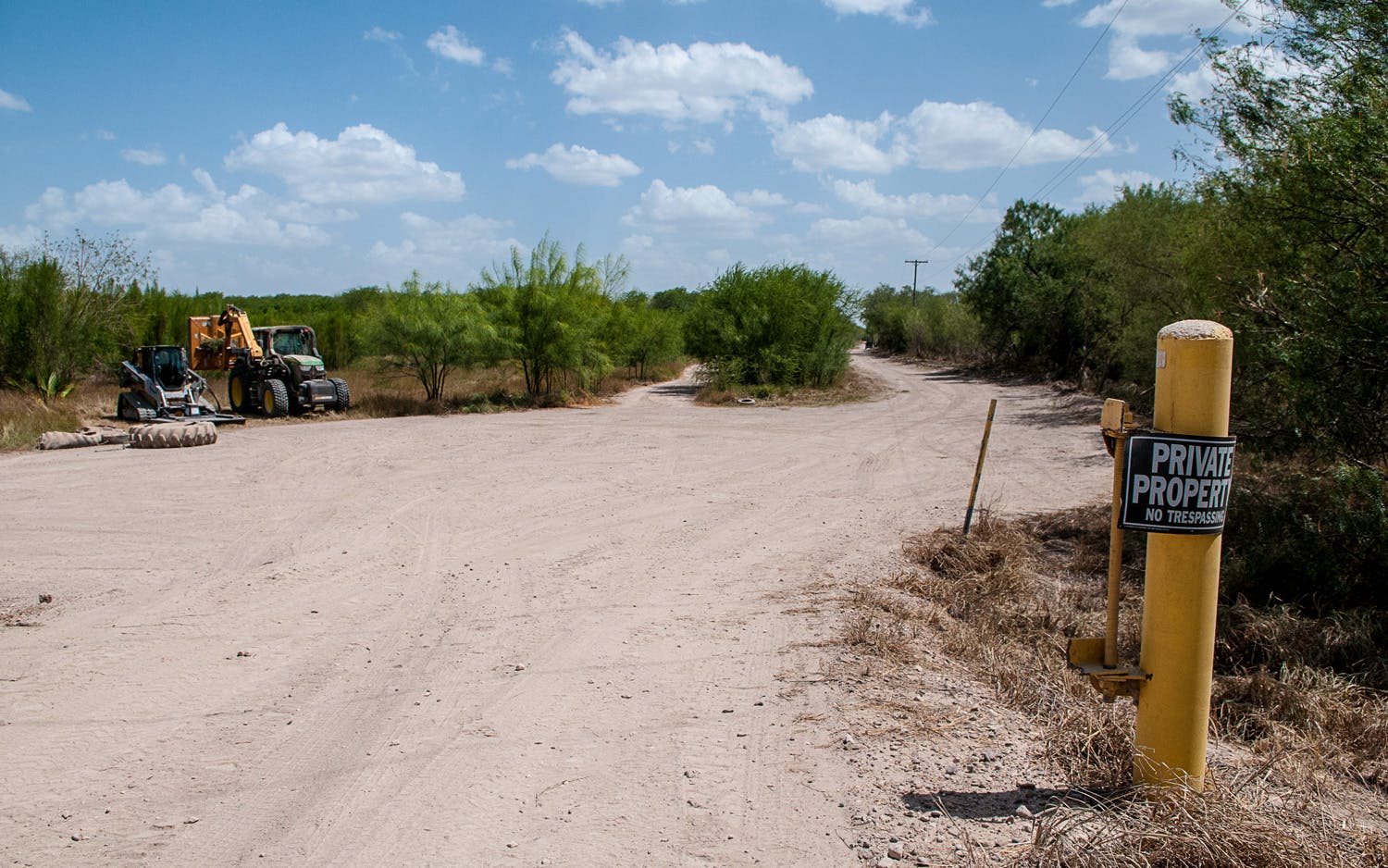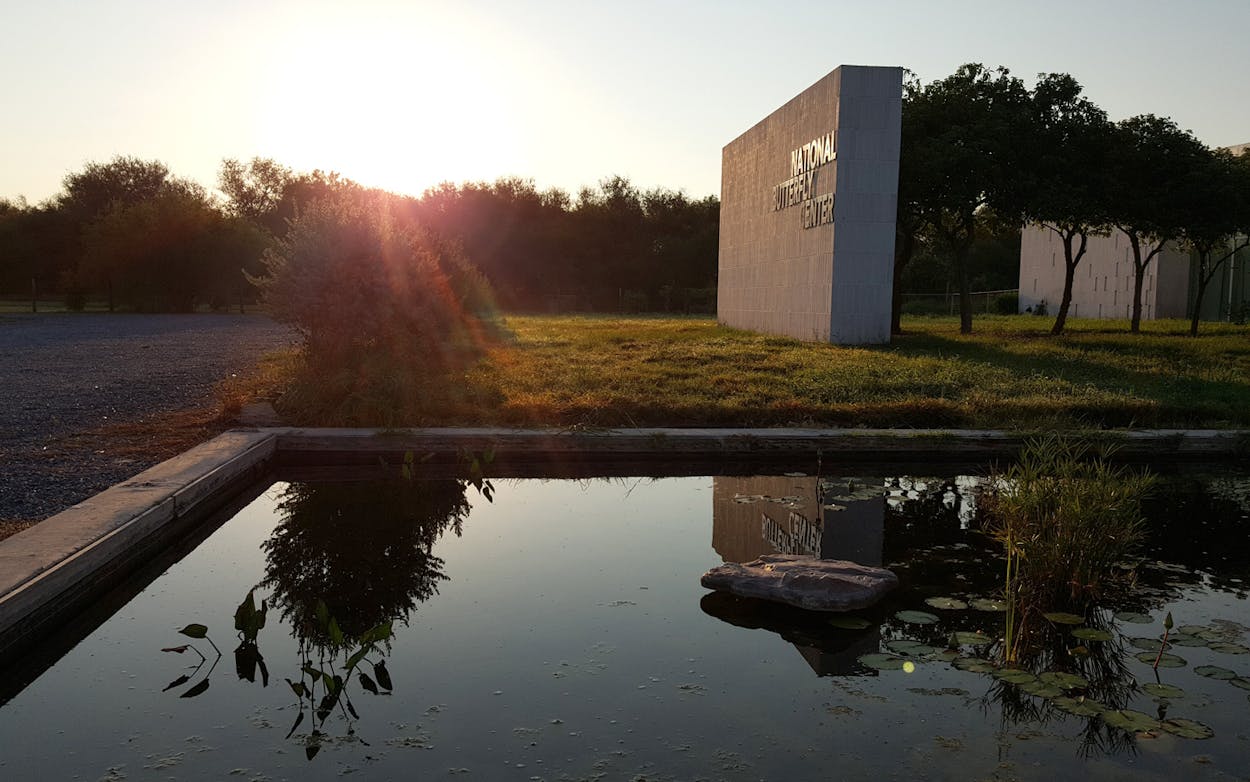Mission, Texas was well on its way to establishing itself as the butterfly capital of America. In 2002, the North American Butterfly Association founded the National Butterfly Center on a former onion farm near Mission. The one-hundred-acre nature preserve features one of the largest native plant botanical gardens in the country, including hundreds of host plants that attract butterflies. The town embraced its new attraction. Every fall, during the annual Monarch migration, the center hosts the Texas Butterfly Festival, which draws thousands of butterfly lovers from around the world to South Texas.
But recently, the National Butterfly Center has found itself caught up in the controversy over President Trump’s proposed border wall. Suddenly, the center’s future is unclear.
On July 20, Marianna Wright, the center’s executive director, was driving through the property when she spotted a work crew cutting down trees and brush along a dirt road leading to the Rio Grande, which abuts the preserve. The crew told Wright that they were with Tikigaq Construction, an Alaska-based contractor for U.S. Customs and Border Protection (CBP), which had hired them to widen the road. Tikigaq directed all questions to the CBP, which confirmed to Texas Monthly that it had hired the company.
No one had given notice that road work would be taking place, much less asked permission, so Wright ordered the crew off the property. The next morning, Wright said, five Border Patrol agents showed up at the center. When Wright told them what had happened, they didn’t believe her, so she took them to the downed trees at the worksite. “They were pretty shocked,” she recalled. “They told me they would try repair the damage and that the habitat would be allowed to regrow.”

Repairs never happened, and a follow-up meeting scheduled for August 1 was cancelled. Instead, Wright received an unscheduled visit from Manuel Padilla, the Border Patrol’s sector chief for the Rio Grande Valley. Padilla explained that the crew had been on the property as part of the Border Patrol’s “comprehensive tactical infrastructure maintenance and repair” program. He apologized that the center hadn’t been notified, but said the men would be back—this time accompanied by armed Border Patrol agents. (At the time this article published, the crew had not returned.)
And that wasn’t all. Padilla showed Wright proposed designs for Trump’s border wall, which, if funded, would be built along a levee running through the center’s property. Wright believes the crew is trying to widen the road to allow heavy construction vehicles like cement mixers access to the levee to build the wall. News of the wall wasn’t totally unexpected. On July 17, three days before she discovered the workers on the center’s property, Wright said she received an unofficial visit from “an employee of a federal agency” with whom she was friendly. “The person said a border wall would be built on the levee here, sooner rather than later, and that we needed to get our ducks in a row if we want to fight it.”
In the past, the center has maintained relatively good relations with the Border Patrol, whose agents are allowed to traverse its land during the course of their official duties. In 2014, the center signed an agreement allowing the Border Patrol to install a gate across the access road between the Rio Grande and the front of the property, to which Wright would have the key code.
Dr. Jeffrey Glassberg, the founder and president of the North American Butterfly Association, was infuriated when Wright told him about the unauthorized tree clearing. He immediately sent a letter to the Border Patrol cancelling the agreement they had signed for the gate. “That agreement gives them permission to maintain the existing road, not widen it,” he said. “They’re clearly abusing it.” In an emailed statement to Texas Monthly, the CBP offered a slightly different take on the arrangement. “CBP does have a license with the Butterfly Center to conduct the [comprehensive tactical infrastructure maintenance and repair] work,” the statement said. “Typically, part of the process includes notifying the Butterfly Center about the work before it takes place, which unfortunately did not occur in this instance.”
Now, Wright and Glassberg are raising money to fight the Border Patrol in court. They started a crowdfunding campaign that, at the time of publication, had raised $6,562 toward its $100,000 goal. It also seems that the center is trying to drum up publicity for its cause: Wright released a video of herself driving around the center, pointing out where the wall will be built, and the center has been putting updates on its Facebook page.
The butterfly center isn’t the only South Texas nature preserve threatened by the border wall. A recent investigation by the Texas Observer revealed that Customs and Border Protection officials have been planning for at least the past six months to build a wall through the Santa Ana Wildlife Refuge, a federally-owned, 2,088-acre preserve in the nearby city of Alamo. According to Reuters, Customs and Border Protection plans to use the 2005 Real ID Act, which exempts it from environmental regulations under certain circumstances, to avoid having to conduct environmental impact studies before building the wall.
The CBP said that during the research and planning process for the wall, “it would be premature to speak about specific locations.” It said that the only specific projects in the works are 35 gaps on the wall, where gates will be installed.
Glassberg said he intends to fight any attempt to build a wall across the Butterfly Center’s property, which is owned by the North American Butterfly Association. “You know, the U.S. government can legally expropriate land through eminent domain, if they go through the courts and pay fair market value,” he said. “But that isn’t the process they’re going through. This is the U.S. government just going in and screwing people. Americans should be really alarmed that the government, with no legal basis whatsoever, is coming onto our land and doing whatever they want.”
In addition to cutting off visitor access to two-thirds of the center’s property, creating a kind of no man’s land between it and the Rio Grande, Glassberg fears that the wall would deter some visitors. “People come to the butterfly center for a good experience, to be out in nature,” he said. “Having a wall going through it does not make them feel all warm and fuzzy.”








